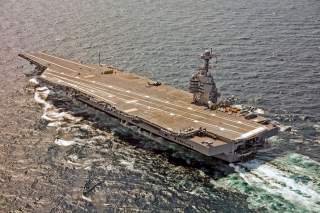An Electro-Magnetic Aircraft Carrier?
The U.S. Navy's got one!
Key Point: Aircraft carriers equipped with the EMALS system will be able to launch planes faster than ever.
The Navy now plans to use electromagnetic force to launch an F/A-18 Super Hornet fighter jet up into the sky off of the deck of its new next-generation aircraft carrier next year – the USS Gerald R. Ford.
The advent of the Navy’s Electro-Magnetic Aircraft Launch System, or EMALS marks the first time in 60-years that a fighter has shot off of a ship without using the current steam-catapult systems, senior Navy officials have said.
The first EMALS system has been under construction for several years aboard the USS Gerald R. Ford, or CVN 78, the first in class of the new carriers -- recently delivered to the Navy.
Ship integration of EMALS technology marked a substantial milestone in a program which had previously conducted deadload launches off of a ship and from land-based flight tests at the Navy facility in Lakehurst, NJ.
The EMALS system consists of a series of transformers and rectifiers designed to convert and store electrical power through a series of motor generators before bringing power to the launch motors on the catapults, Navy officials have explained.
By having an electrical pulse come down, the aircraft is pulled down to the catapult to launch; the precise weight of the aircraft can be dialed in. As the aircraft accelerates the catapult, it can reach the precise speed it needs to launch, senior Navy officials said.
Unlike steam catapults, which use pressurized steam, a launch valve and a piston to catapult aircraft, EMALS uses a precisely determined amount of electrical energy. As a result, EMALS is designed to more smoothly launch aircraft while reducing stress and wear and tear on the airframes themselves.
On the ship, EMALS will be engineered such that any of the ship’s four catapults will be able to draw power from any one of three energy storage groups on the ship, officials said.
Previous ground-based EMALS catapult tests have launched EA-18G Growlers, F/A-18 Super Hornets, C-2 Greyhound planes and E2D Advanced Hawkeyes, among others. In fact, EMALS even launched an F-35 Joint Strike Fighter at Lakehurst, Navy officials said.
Metal decking is placed over the trough on the flight deck. Cabling and linear induction motor sections have been installed on board the USS Ford.
The linear motors are engineered to help create a sequentially activated rolling magnetic field or wave able to thrust or propel aircraft forward, Navy program officials explained.
Navy officials said It is the same type of technology used in a rollercoaster designed for critical launch reliability. An electromagnetic field turns on linear motor sequentially so as not to energize the whole field in one shot, Navy experts added.
The electromagnetic field acts on a large 22-foot long aluminum plate. The aluminum plate runs in between stationary sections of 12-foot long linear motors. Electricity runs through the two sides of the motors, creating an electromagnetic wave.
Aircraft motors are kicked in and then a hydraulic piston pushes a shuttle forward. The shuttle is what connects to the aircraft launch bar, developers explained.
The EMALS system can adjust to different aircraft weights and configurations. For example, EMALS is configured such that it could launch a lighter weight aircraft, such as an unmanned aircraft system.
This is particularly useful because the amount of thrust needed to launch an aircraft depends upon a range of interwoven factors to include size, shape and weight of the aircraft, wind speed on the carrier deck and the speed of the aircraft carrier in the water, Navy program managers said.
EMALs is engineered to support current and future air-wing configurations; it is designed to accommodate a future air wing that requires higher energy launches.
The USS Ford is able to generate 13,800 volts of electrical power, more than three times the 4,160 volts that a Nimitz-class carrier generates, Navy engineers have explained.
The EMALS system is also engineered to work in tandem with the USS Ford’s new Advanced Arresting Gear, or AAG. Unlike the existing hydraulic system used on current aircraft carriers, AAG is a mechanical electrical system with a cable that spins a water twister.
Similar to EMALS, the AAG is also designed to reduce stress on the airframe during the landing process.
This first appeared in Scout Warrior here. This piece was first featured in June 2017 and is being republished due to reader's interest.
Media: Reuters

